What is Interceptive Orthodontics?
Interceptive orthodontics is defined as any treatment procedure that eliminates or reduces the severity of a developing malocclusion1. Early diagnosis of certain features of a malocclusion in the growing child and its early intervention by using removable appliances or simple fixed appliances by the dentist/orthodontist will reduce the complexity of the malocclusion from developing as the child grows older 1,2,3.
Removable appliances are braces that can be taken off during eating and tooth brushing. Fixed appliances on the other hand, are attached to the teeth and cannot be removed by the patient.
When is the right time to do Interceptive Orthodontics?
Interceptive orthodontics is usually done in the mixed dentition stage (See Table 1).
|
Dentition stage
|
Normal occlusal development
|
|---|---|
| Primary dentition (3-6 years old) |
By the age of 3, a child will normally have all 20 “erupted” primary teeth in the mouth. An intact and healthy primary dentition plays an important role in maintaining the dimensions and form of the dental arches during the eruption of the permanent dentition. Interception is rarely done in the primary dentition |
| Mixed dentition (6-12 years old) |
The mixed dentition starts when the lower 1st permanent molar starts to erupt in the mouth at about the age of 6 years. The permanent incisors will erupt at about 7-8 years old. This is followed by the eruption of the premolars and canines (9-11 years) and second molars (12 years).
Interceptive orthodontics is usually done in the mixed dentition. |
| Permanent dentition (> 12 years old) |
By 12-13 years of age, the permanent dentition including the 2nd molars has usually erupted in the mouth and all the primary teeth have shed. The 3rd molar usually erupts later at age 18-21 years.
Growth modification to treat a skeletal problem of the jaw is best done in the late mixed dentition or early permanent dentition when growth is most active4 (11-14 years of age). |
Table 1
What are the common types of interceptive orthodontic management?
The most common types of interceptive orthodontic management includes :
- Treatment of simple anterior crossbite
- Space management following early loss of teeth with a space maintainer
- Screening for palatally ectopic upper canines
- Treatment of local factors:
- Unerupted teeth
- Supernumerary teeth
- Retained primary teeth
- Habits such as thumb/dummy sucking
- Management of Skeletal 2 cases with Functional Appliances
- Treatment of Simple Anterior Crossbite
An anterior crossbite occurs when one or two of the upper permanent incisors bite lingual to (behind) the lower permanent incisors5. Early interceptive treatment is recommended (7-10 years old) if the crossbite causes the lower teeth to be loose, or if there is a gingival recession due to a traumatic bite6.
Treatment is usually done by making an Upper Removable Appliance (URA) to tip the upper incisor over the lower teeth (Fig 1a, b and c). Simple anterior crossbite usually takes 3-6 months to correct with a URA.
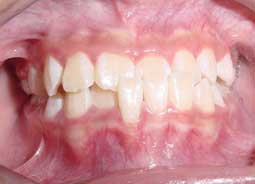
a) Before treatment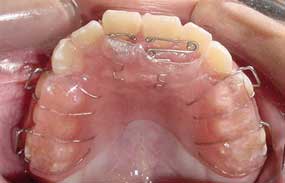
b) During treatment with URA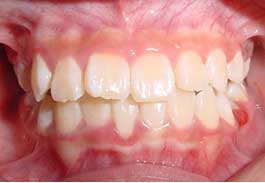
c) Crossbite corrected.Fig.1. Anterior crossbite case.
- Space Management Following Early Loss of Teeth with a Space Maintainer A space maintainer is an intra-oral appliance that is used to preserve the space, usually following the early loss of primary teeth/tooth. Early loss of an upper or lower primary second molar allows the first permanent molar to move forward resulting in future crowding of the premolar. A space maintainer called a Lingual Arch (Fig 2) or a ‘Band and Loop’ appliance can be used to prevent this. Likewise, if a child loses upper permanent incisor through a fall or extraction, the space will usually become smaller as the adjacent teeth will encroach on the space. In this case a denture can act as a space maintainer and should be done as soon as possible for the patient, as space closure occurs rapidly in the first 3 months and slows a little up to 9 months7.
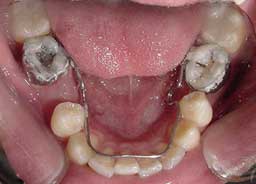
Fig. 2. A lingual arch to maintain space - Screening for Palatally Ectopic Upper Canines
The upper canines are the second most commonly impacted permanent teeth, after the lower third molars. The ectopic canines occur two times more often palatally than buccally. Early diagnosis and effective management of palatally ectopic upper canines is crucial as failure to do so may result in more complex remedial treatment later8.
Screening for ectopic upper canines is best done between the ages of 10-11 years where they should be palpable in the buccal sulcus in the majority of normally erupting canines. In selected cases there is some evidence to show that interceptive extraction of primary canines can result in an improvement of the position of ectopic permanent canines. However if radiographic examination shows no improvement in their position after 12 months following extraction, alternative treatment should then be considered8.
- Treatment of Local Factors
-
- Delayed/Unerupted Permanent Teeth
A child may present with a delayed or unerupted permanent teeth (all incisors should have erupted by age 9). Any abnormality in the timing or sequence of eruption should act as a trigger for further investigation. If a permanent tooth on one side of the dental arch has erupted, the tooth on the other side should erupt within 6 months.
Delayed eruption can be due to crowding or the presence of a supernumerary (extra tooth/teeth, Fig 3) which impedes their eruption. Asymmetric eruption of teeth should be monitored and thorough investigation is warranted. An x-ray i.e Orthopantomogram (OPG)/Anterior occlusal can be taken to identify any abnormality associated with the unerupted teeth. Early interception to remove the supernumerary is recommended.9
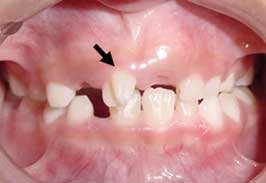
a) erupted in the midline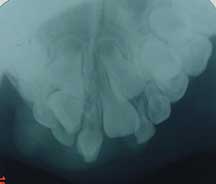
b) impeding eruption of central incisorsFig. 3. A supernumerary tooth in a 8-year-old boy.
- Delayed/Unerupted Permanent Teeth
- Retained Primary Teeth
Primary teeth which fail to shed more than 6 months after the eruption of contralateral teeth will require further investigation. Provided that the permanent successor is present, retained primary teeth should be extracted if they are causing deflection of the permanent teeth10.
- Thumb/Dummy Sucking Habit
A thumb/dummy sucking habit may cause the front teeth to have an open bite (Fig.4a). If identified early, passive means of intervention should be carried out to stop the habit. If this fails, a habit-breaker appliance (Fig.4b) is recommended to break the habit. If intercepted early before the eruption of permanent incisors, the open bite usually corrects itself.
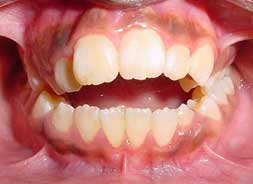
Fig.4a) Anterior open bite resulting from thumb sucking habit.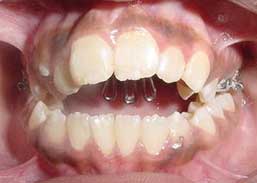
Fig.4b) Habit-breaker appliance in place.
-
- Management of Skeletal 2 cases With Functional Appliances
A Skeletal 2 problem occurs when the lower jaw is positioned too far back (retrognathic mandible) in relation to the upper jaw. This will result in protruded upper incisors (increased overjet). A normal overjet is 2-4 mm. An overjet of more than 9 mm is considered severe. Patient usually cannot close their mouth and these protruded teeth are more prone to traumatic injuries 11, 12, 13. They may also have psychosocial problems from being teased by their peers14.
Treatment with functional appliances during their active growth (pubertal growth spurt) is recommended to correct the overjet and improve their self-esteem 15. In severe skeletal problem, functional appliance may reduce the severity of the problem however it may not avoid the need for jaw surgery later.
Functional appliance is a removable brace that works on upper and lower teeth at the same time. These braces are usually worn full time for duration of 9-12 months depending on how severe the case is. Then, the brace may be worn at night for a while or progress to a second phase of treatment with a different type of brace 15 Fig. 5 shows a Twin Block type of functional appliance to correct a Skeletal 2 problem.
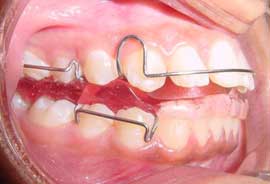
Fig. 5. A Twin Block type of functional appliance in the mouth
Conclusion
Interceptive orthodontics is beneficial as it reduces the severity of a developing malocclusion 1,2,3 simplifies future orthodontic management as well as reduces the complexity and cost of treatment16.
References
- Popovich, F. & Thompson, G.W. (1975). Evaluation of preventive and interceptive orthodontic treatment between 3 and 18 years of age. Transactions of Third International Congress of Orthodontics, 26-33.
- Dugoni, S.A. (1998). Comprehensive mixed dentition treatment. Am J Orthod Dentofacial Orthop, 113, 75-84.
- Al Nimri, K., Richardson, A. (2000) Interceptive Orthodontics in the real world of communitydentistry. International Journal of Pediatric Dentistry, 10, 99-108.
- O’Brien, K., Wright, J., Conboy, et al. (2003).Effectiveness of early orthodontic treatment with the Twinblock appliance: A multicenter, randomized, controlled trial. Part 1: Dental and Skeletal Effects. Am J Orthod Dentofacial Orthop. 124, 234-243.
- Richards, B. (2001). An approach to the diagnosis of different malocclusions. In Bishara SE, ed. Textbook of Orthodontics. Philadelphia Pa.: Saunders Co.
- Stellard, R.E. (1968). Occlusion, a factor in periodontal disease. International Dental Journal 18, 121-132.
- Foster, T.D. (1991). A Textbook of Orthodontics. Oxford: Blackwell Scientific Publications
- Husain, J., Burden, D., McSherry, P. (2010) Management of the Palatally Ectopic Maxillary Canines. Clinical Guidelines-The Royal College of Surgeons of England. Retrieved August 12, 2011, from www.rcseng.ac.uk/fds/clinical_guidelines
- Mosby’s Medical Dictionary, 8th edition. (2009). Elsevier.
- Mitchell, L. (2007). An Introduction to Orthodontics. Oxford: Oxford University Press
- Jarvinen, S. (1977). Incisal overjet and traumatic injuries to upper permanent incisors. Acta Odontol. Scan. 36, 359-362
- O’Mullane, D.M. (1973). Some factors predisposing to injuries of permanent incisors in school children. British Dental Journal 134, 328-332.
- Nguyen, O.V., Bezemer, P.D., Habets, L. & Prahl-Andersen, B. (1999).A systematic review of the relationship between overjet size and traumatic dental injuries. European Journal of Orthodontics 21, 503-515.
- O’Brien, K., Wright, J., Conboy, et al. (2003).Effectiveness of early orthodontic treatment with the Twinblock appliance: A multicenter, randomized, controlled trial. Part 2: Psychosocial effects. Am J Orthod Dentofacial Orthop. 124, 488-95.
- British Orthodontic Society (2011) Functional Appliance. Patient Information leaflet. Retrieved August 16, 2011, from www.bos.org.uk/index/patientinformationleaflet/functional.
- Al Nimri, K. & Richardson, A. (1997). The applicability of interceptive orthodontics in the community. British Journal of Orthodontics 24, 223-228.
| Last Reviewed | : | 28 Ogos 2020 |
| Writer | : | Dr. Zainatul Akmar bt. Khalil |
| Accreditor | Dr. Hjh. Che Fatimah bt. Awang | |
| Reviewer | : | Dr. Hjh. Rashidah bt. Dato’ Hj. Burhanuddin |







